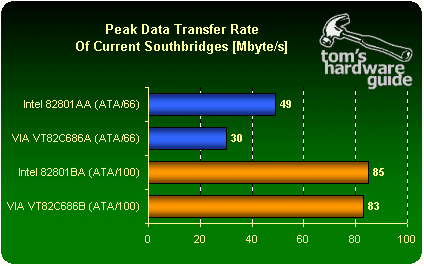5 New SocketA Boards With UltraATA/100
The Disk Data Tranfers Rates Of 686A And 686B
We checked the maximum data transfer rate with an ATA/100-hard disk connected to the 686A and 686B. We compared each VIA-chipset with its counterpart from Intel. The following results represent the data transfer rate when reading data from the hard disk's cache memory modules, not the actual physical disks.
We already expected that, due to the overhead, the transfer protocol would not reach the theoretically possible 66 and 100 MByte/s. ATA66 reaches 55-57 MB/s, so the overhead-loss is about 13 - 15%. The results of ATA100 are slightly worse. With 15 and 17 % respectively overhead compared to the theoretical maximum, the effectiveness is very similar ATA/66.
Benchmark Expectations
What do these results mean in practical life? First we have to know the influence of basic hard drive performance numbers on overall system performance. These are the sustained transfer rates and access times. The sustained transfer rate is the maximum transfer rate of data coming from the actual platters (disks), which is also known as disk-to-interface speed. This should not be mixed up with the much higher maximum transfer rate of data coming from the cache chips (cache-to-interface speed), which is obviously the preferred number quoted by marketing departments of hard disk manufacturers. In real life the hard drive cache can only show its strength in certain applications.
Modern hard disks offer a sustained data transfer rate of 35 MByte/s and more. Therefore, the UltraATA/66 should have some reserves left. We expect marginal performance increases in business applications when using ATA100 with the 686B, as reported by Sysmark 2000. We do not expect any improvement with games and OpenGL benchmarks because hard rive performance doesn't have any impact on frame rates.
Get Tom's Hardware's best news and in-depth reviews, straight to your inbox.
Current page: The Disk Data Tranfers Rates Of 686A And 686B
Prev Page The Difference Between 686A And 686B Next Page Do Not Forget To Cool Your AMD-CPU
